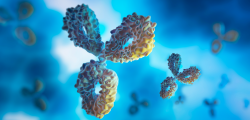GenCrispr NLS-Cas9-EGFP is a fusion protein developed by GenScript. It contains a nuclear localization signal (NLS) on its N terminal end, and an EGFP and a 6x(His) sequence on the C terminal end. Cas9 nuclease is an RNA-guided endonuclease that can catalyze cleavage of double stranded DNA. This kind of targeted nuclease is a powerful tool for genome editing with high precision. Cas9 protein forms a highly stable ribonucleoprotein (RNP) complex with the guide RNA (gRNA) component of the CRISPR/Cas9 system. When Cas9 is expressed with an NLS sequence, the Cas9 RNP complex can localize to the nucleus immediately upon entering the cell. There is no requirement for in vivo transcription or translation, which improves the efficiency of this method over plasmid-based systems. Additionally, the Cas9 RNP complex is rapidly cleared from the cells minimizing the chance of off-target cleavage when compared to other systems (Kim, et al. 2014). The EGFP tag can be used as a reporter for tracking or sorting transfected cells, which enables enrichment of cell populations for desired genome edits via fluorescence activated cell sorting (FACS). It significantly reduces the labor and cost associated with single cell cloning and genotyping in genome editing applications.
Product Source: GenCrispr NLS-Cas9-EGFP is produced by expression from an E. coli strain.
Key Features
- DNA-free: no external DNA added to system
- High cleavage efficiency: NLS ensures the efficient entry of the Cas9 protein into nuclei
- Low off target effects: transient expression of Cas9 nuclease improves specificity of cleavage
- Time-saving: no need for transcription and translation
- Reduced labor: enrich cell populations for desired genome edits via EGFP-based FACS. The C-terminal His-tag increases the choice of detection methods for the fusion protein.
Application
- Screening for highly efficient and specific targeting gRNAs by in vitro DNA cleavage.
- In vivo gene editing when combined with a specific gRNA by electroporation or injection.
- Enrichment of cell populations for desired genome edits via EGFP-based FACS.
|






































